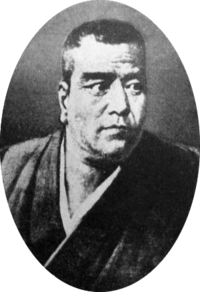 |
| Chiossone's famous portrait of Saigo Takamori |
One of the famous portraits which everyone knows in Japan is Saigo Takamori’s one. When we were elementary students, we had to look at him in our history textbooks many times. However, I guess there are few people who know who drew this portrait. Now, I will introduce a man who drew Saigo’s portrait. His name is Edoardo Chiossone. He was born in Italy, and was an artist. His family was running a business of printing and plate making. So, from 14 to 22 years old, he learned copperplate engraving at an art school. Then he won the special prize and become a professor. Besides these, he won the silver prize in international exposition in Paris in 1867. After that he was interested in making paper money and got a job in a bank in Germany in 1868. At that time, this company was producing the government bills called Meiji Tsuho and he also had to do with manufacturing.
In 1875, he was invited by Okuma Shigenobu and came to Japan. Then, Okuma showed the exceptional pay for Chiossone and gave him the chance to make use of his engraving skill. Why he was invited? That’s because it was a problem for Meiji government to produce elaborate paper bills that could not be forged. If Japan continude asking the foreign company, it would have been very expensive and not safe, so Meiji government sought the person who could introduce the techniques to aim for nationalization.
I said a short while ago that Saigo Takamori’s portrait was drawn by Chiossone. However, Chiossone had never seen him and did not have his picture, so how did he draw his portrait? He got an advice from Tokuno Ryosuke he is nepotism of Saigo. And he made the image based on the model of Saigo Jyudo, Takamori’s young brother, and Oyama Iwane, Saigo brother’s cousin. And his most famous portrait is Meiji Emperor’s one.
In my opinion, Chiossone really liked his field of learning. And he contributed many things to Japan. It is not just historical event, also facts we directly touch. For instance, as I have said before, it means we learnt Japanese history in elementary school. Then, we recognized “Saigo Takamori” with that portrait that everyone knows. I am wondering about that because though the portrait was drawn a long time ago, we who are living now use it and learn history. It is interesting to connect past and present.
However, this portrait is not real. It means it is not based on Saigo himself. So, I heard an interesting fact. As you know, the statue of Saigo is in Ueno. It is based on his portrait, so this statue is also not Saigo’s real appearance. One day, his wife visited to Ueno, but she said “this is not my husband”. Is it interesting, isn’t it? In other words, we will never recognize the real Saigo’s appearance thanks to Chiossone. However, Chiossone is one of the person who gave us source of learning and significance. Now, I feel glad that he came to Japan.
No comments:
Post a Comment